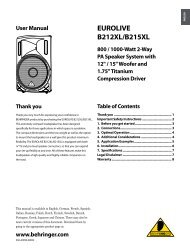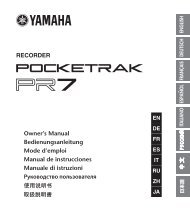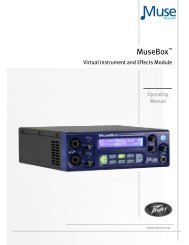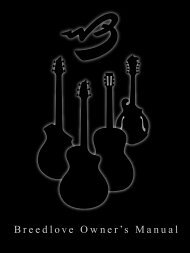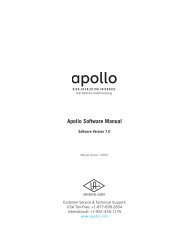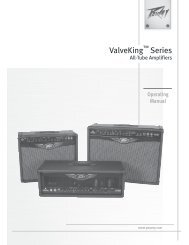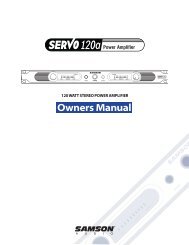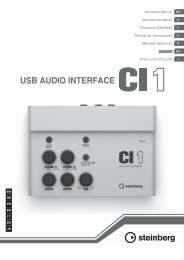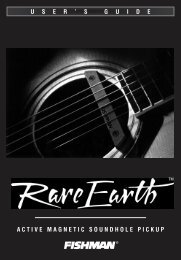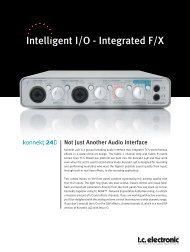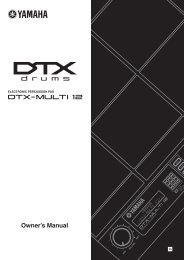Create successful ePaper yourself
Turn your PDF publications into a flip-book with our unique Google optimized e-Paper software.
Backing Module <strong>BK</strong>-<strong>7m</strong><br />
MFX types and parameters<br />
r<br />
9. Rotary<br />
This effect simulates the sound of the rotary speakers often<br />
used with the electric organs. Since the movement of the highrange<br />
and low-range rotors can be set independently, the<br />
unique type of modulation characteristic of these speakers can<br />
be simulated quite closely. This effect is most suitable for electric<br />
organ sounds (of the [ORGAN] bank – the Harmonic Bar section<br />
has its own Rotary effect).<br />
● Tweeter Slow Rate (0.05~10.0Hz)<br />
● Woofer Slow Rate (0.05~10.0Hz)—Slow speed (SLOW) of the<br />
high- or low-frequency rotor.<br />
● Tweeter Fast Rate (0.05~10.0Hz)<br />
● Woofer Fast Rate (0.05~10.0Hz)—Fast speed (FAST) of the highor<br />
low-frequency rotor.<br />
● Rotary Speed (Slow, Fast)—Simultaneously switches the rotational<br />
speed of the low-frequency and high-frequency rotors.<br />
SLOW: Slows down the rotation to the “Slow Rate”. FAST:<br />
Speeds up the rotation to the “Fast Rate”.<br />
● Tweeter Acceleration (0~15)<br />
● Woofer Acceleration (0~15)—Adjusts the time it takes the rotor<br />
in question to reach the newly selected speed (“Fast” or<br />
“Slow”). Lower values correspond to slower transitions.<br />
● Tweeter Level (0~127)<br />
● Woofer Level (0~127)—Volume of the rotor in question.<br />
● Separation (0~127)—Spatial dispersion of the sound.<br />
● Level (0~127)—Output level.<br />
10. Compressor<br />
Reduces high levels (peaks) and boosts low levels, smoothing<br />
out fluctuations in volume.<br />
● Compressor Sustain (0~127)—Allows you to specify how<br />
strongly incoming signals should be compressed, which results in<br />
a longer sustain.<br />
● Compressor Attack (0~127)—Sets the speed at which compression<br />
starts.<br />
● Panpot (L64~0~63R)—Stereo location of the output sound. This<br />
is a mono effect that combines incoming signals. You can, however,<br />
place the processed signal anywhere between the left and<br />
right channels.<br />
● Compressor Post Gain (0, +6, +12, +18dB)—Adjusts the output<br />
gain. Use this parameter to make up for a significant volume<br />
loss due to extreme settings.<br />
● EQ Low Gain (–15dB~0~15dB)—Gain of the low range.<br />
● EQ High Gain (–15dB~0~15dB)—Gain of the high range.<br />
● Level (0~127)—Output level.<br />
11. Limiter<br />
Compresses signals that exceed the specified level, preventing<br />
distortion from occurring. Unlike a compressor, it does not<br />
boost the level of weaker signals.<br />
● Limiter Threshold (0~127)—Adjusts the volume at which compression<br />
begins.<br />
● Limiter Release (0~127)—Allows you to specify how long signal<br />
compression should remain in effect after the signal volume<br />
falls below the Threshold value.<br />
● Limiter Ratio (1.5:1, 2:1, 4:1, 100:1)—Allows you to specify how<br />
strongly volume peaks should be compressed. Choose “100:1” if<br />
the Threshold level must never be exceeded (which is a true Limiter<br />
function).<br />
● Panpot (L64~0~63R)—Stereo location of the output sound. This<br />
is a mono effect that combines incoming signals. You can, however,<br />
place the processed signal anywhere between the left and<br />
right channels.<br />
● Limiter Post Gain (0, +6, +12, +18dB)—Adjusts the output gain.<br />
Use this parameter to make up for a significant volume loss due<br />
to extreme settings.<br />
● EQ Low Gain (–15dB~0~15dB)—Gain of the low range.<br />
● EQ High Gain (–15dB~0~15dB)—Gain of the high range.<br />
● Level (0~127)—Output level.<br />
108<br />
12. Hexa-Chorus<br />
Uses a six-phase chorus (six layers of chorused sound) to create<br />
a dense and spatial effect.<br />
● Chorus Pre Delay (0.0~100.0ms)—Adjusts the delay between the<br />
incoming direct signal and the moment when the chorus starts<br />
working.<br />
● Chorus Rate (0.05~10.0Hz)—Frequency, i.e. modulation speed.<br />
● Chorus Depth (0~127)—Modulation intensity.<br />
● Chorus Pre Delay Deviation (0~20)—Adjusts the differences in<br />
Pre Delay between each chorus line (there are six of them).<br />
● Chorus Depth Deviation (-20~0~20)—Adjusts the difference in<br />
modulation depth between each chorus sound.<br />
● Chorus Pan Deviation (0~20)—Adjusts the distribution of the<br />
various chorus lines in the stereo image.<br />
0: All chorus sounds are in the center.<br />
20: Each chorus sound will be spaced at 60 degree intervals relative<br />
to the center.<br />
● Balance (D100:0W, D50:50W, D0:100W)—Volume balance<br />
between the direct (D) and the effect sound (W).<br />
● Level (0~127)—Output level.<br />
13. Trem Chorus<br />
This is a chorus effect with added Tremolo (cyclic modulation<br />
of volume).<br />
● Chorus Pre Delay (0.0~100.0ms)—Adjusts the delay between the<br />
incoming direct signal and the moment when the chorus starts<br />
working.<br />
● Chorus Rate (0.05~10.0Hz)—Frequency, i.e. modulation speed.<br />
● Chorus Depth (0~127)—Modulation intensity.<br />
● Tremolo Rate (0.05~10.0Hz)—Modulation frequency of the<br />
tremolo effect.<br />
● Tremolo Separation (0~127)—Allows you to set the level of the<br />
tremolo effect with respect to the chorus modulation.<br />
● Tremolo Phase (0~180 deg)—Spread of the tremolo effect.<br />
● Balance (D100:0W, D50:50W, D0:100W)—Volume balance<br />
between the direct (D) and the effect sound (W).<br />
● Level (0~127)—Output level.<br />
14. Space-D<br />
This is a multiple chorus that applies two-phase modulation in<br />
stereo. It gives no impression of modulation, but produces a<br />
transparent chorus effect.<br />
● Chorus Pre Delay (0.0~100.0ms)—Adjusts the delay between the<br />
incoming direct signal and the moment when the chorus starts<br />
working.<br />
● Chorus Rate (0.05~10.0Hz)—Frequency, i.e. modulation speed.<br />
● Chorus Depth (0~127)—Modulation intensity.<br />
● Chorus Phase (0~180deg)—Spatial spread of the sound.<br />
● EQ Low Gain (–15dB~0~15dB)—Gain of the low range.<br />
● EQ High Gain (–15dB~0~15dB)—Gain of the high range.<br />
● Balance (D100:0W, D50:50W, D0:100W)—Volume balance<br />
between the direct (D) and the effect sound (W).<br />
● Level (0~127)—Output level.<br />
15. St. Chorus<br />
This is a stereo chorus. A filter is provided so that you can<br />
adjust the timbre of the chorus sound.<br />
● Filter Type (OFF, LPF, HPF)—Type of filter. OFF: no filter is used.<br />
LPF: cuts the frequency range above the Cutoff value. HPF: cuts<br />
the frequency range below the Cutoff value.<br />
● Cutoff Frequency (200~8000Hz)—Basic frequency of the filter.<br />
● Chorus Pre Delay (0.0~100.0ms)—Adjusts the delay between the<br />
incoming direct signal and the moment when the chorus starts<br />
working.<br />
● Chorus Rate (0.05~10.0Hz)—Frequency, i.e. modulation speed.<br />
● Chorus Depth (0~127)—Modulation intensity.<br />
● Chorus Phase (0~180 deg)—Spatial spread of the sound.<br />
● EQ Low Gain (–15dB~0~15dB)—Gain of the low range.<br />
● EQ High Gain (–15dB~0~15dB)—Gain of the high range.<br />
● Balance (D100:0W, D50:50W, D0:100W)—Volume balance<br />
between the direct (D) and the effect sound (W).<br />
● Level (0~127)—Output level.



